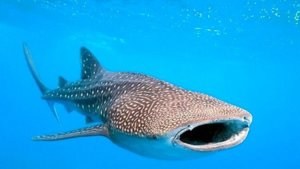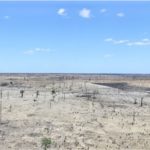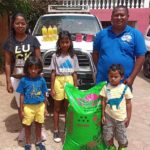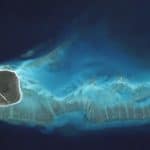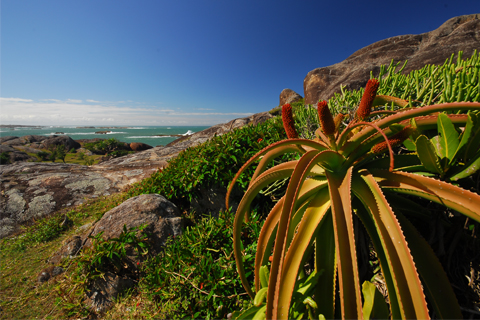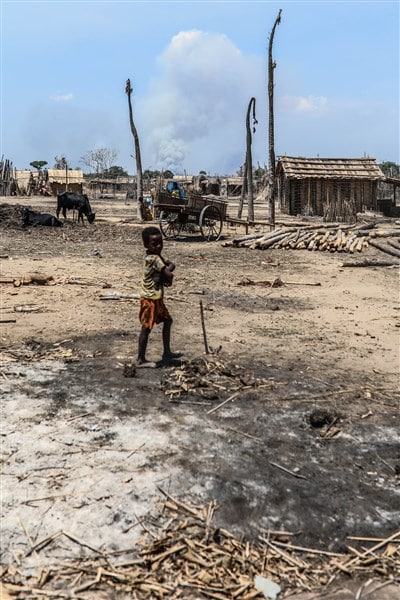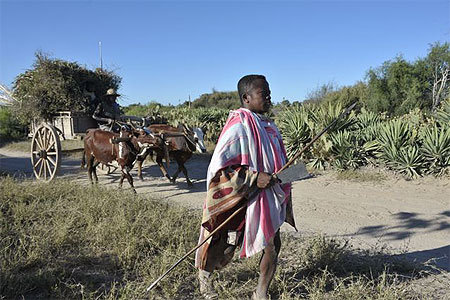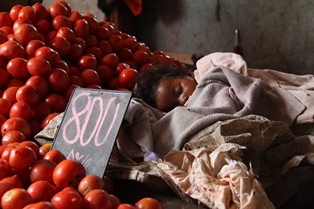The surroundings of Toliara
The RN9, sometimes sandy, sometimes muddy and rutted depending on the season, opens to both great tourism and adventure ...
The dry forest of the Mikea
80 km north of Toliara, west of Ankililoaka and the rich, well-developed Antseva depression 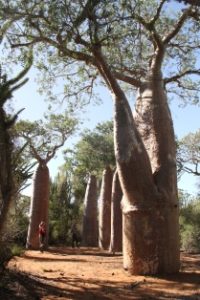 (cotton, corn, rice), begins the Mikea dry forest, named after the hunter-gatherer groups that inhabit it.
(cotton, corn, rice), begins the Mikea dry forest, named after the hunter-gatherer groups that inhabit it.
If today we think that it is Masikoro who fled colonization and forced labor, then we have long wondered about the origins of these isolated forest dwellers who have struggled for their Fortune teller, or ombiasy, are feared.
Thus, in colonial times they were taken for giants or dwarfs, and in the 1950s a dwarf Mikea was even exhibited at fairs of dubious taste!
Ifaty (26 km north of Toliara, on RN 9)
Behind this macabre name ("To the corpse") is a resort that will delight fans of all water sports.
He stands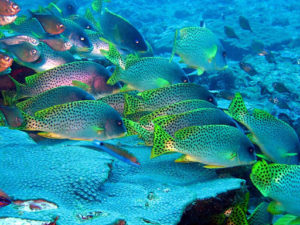 t in front of a huge lagoon where no sharks dare to enter, a paradisiacal place soon to be established as a nature reserve, where you can explore natural aquariums of rare richness at a depth of less than 6 meters, flush out lobsters, groupers and parrotfish in the north and south passes or captains and other marine fish.
t in front of a huge lagoon where no sharks dare to enter, a paradisiacal place soon to be established as a nature reserve, where you can explore natural aquariums of rare richness at a depth of less than 6 meters, flush out lobsters, groupers and parrotfish in the north and south passes or captains and other marine fish.
In the season it is possible to hunt wild ducks and teal in the ponds in the hinterland.
Miary-the village of kings
This village in the Fiherenana Valley, 7 km east of Toliara, houses a huge banyan tree, a sacred tree of the Masikoro dynasty of the Andrevola, and the tombs of its kings.
With the permission of the city council you can visit the grave of Tompomanana (King who died in 1898) to visit on one of the hills built on the river.
On the grave, a pile of dry stones, there are an old sword, a ship's bell and a supposedly authentic Ming vase, testifying to the time of great trade.
South of Toliara (Tulear)
With a good 4×4, a lot of patience and the energy to move the many dead trees that block the way, you can take an extraordinary hike in the hinterland of Tulear, along the River Onilahy to the Seven Sacred Lakes of Ifanato (about 60 km southeast of Toliara, via Ambohimahavelona).
At the end of a journey through a lush gallery forest inhabited by lemurs, you will discover more than twenty lakes arranged in rows on the side of the limestone plateau overlooking the river. Their cool waters are home to surreal whitish mushroom vegetation (swimming is possible).
Arboretum Antsokay
At the southern exit of Toliara, mango and tamarind trees soon give way to thorn and palm trees of the deciduous dry forest.
On PK
Nearby has a Swiss botanist created a garden dedicated to the endemic plants of the southwest and other regions of the island.
This Antsokay arboretum, visited by many researchers, is home to more than a thousand species of plants, lemurs, ray turtles, snakes and chameleons. Lunch and accommodation are available at the adjacent hostel.
This arboretum, which covers almost 4 hectares, is a true museum of the flora of the dry deciduous forest. The local fauna consists mainly of Lemur microcebus, Lizards, Radiated tortoises and bands of Makis.
If you don't stay on site, it's a pleasant half-day escapade that can begin or end with a meal at L'Auberge de la Table restaurant.
On the way back to Toliara you will see some beautiful Antandroy tombs on the left side of the road.
Sarondrano
(About 6 km before Saint Augustin leave dirt road runs along the mangroves to the south).
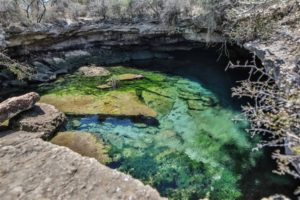
Above the deep sea waters, less than 1 meter from the surface, the water is fresh and cool as in a real natural swimming pool; it is one of the resurgences of the great river Onilahy that flows further south.
Saint Augustin (Anantsono-37 km south of Toliara)
The road, which is getting worse, leads to Saint-Augustin (Anantsono), a town at the mouth of the River Onilahy, at the foot of high cliffs.
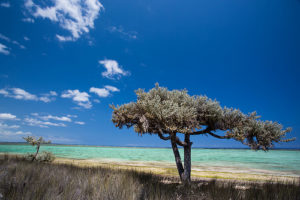
In the 17th century, European merchant ships made this magnificent bay a favorite stopover on their way to India.
After the failure of the project initiated by the Englishman John Smart led colonization attempt in 1645, Saint Augustin became a supply base for European pirates and slave traders - such as the Malouin Surcouf - and then, in the 19th century, one of the most important bases of French colonization in the region, as witnessed by the remains of ocher red buildings on the seafront.
One can ask the local council for permission to visit the sacred complex where the relics of the royal ancestors of the Tetembola dynasty are kept.
Saint Augustin is a center of the Vorombe (Cult of Possession).
The cult objects are kept in the small blue and white painted box, which is located in the center of the city, near the Protestant temple.
Anakao (22Km south of Saint Augustin)
The largest Vezo village in the region is located on a beautiful sandy beach opposite Nosy Ve.

Almost exactly where the Tropic of Capricorn runs, Anakao welcomes you to the magnificent bay of Saint-Augustin. This both wild and picturesque fishing village of the Vezo has nothing to envy other tourist destinations on the Big Island.
The vegetation is not lush, but the beautiful beaches and lagoons, the translucent and turquoise waters, not to mention the hospitality of the inhabitants make it a charming destination. Those looking for a little peace and a moment of solitude will surely find what they are looking for!
Anakao is a cosmopolitan and traditional village
Anakao is located about forty kilometers from Toliara and borders the lagoon in the southwest of the Big Island. The village is the result of the union of several semi-settled fishing villages, composed mainly of fishermen from Vezo and farmers from Tanala.
Its cosmopolitan population comes from the migration of the Mahafaly, Masikoro and Merina. It was a mandatory stopover for sailors traveling to the southern part of the island.
During your stay in Madagascar you will see the beauty of the Malagasy people.
What makes this village so endearing, apart from its white sandy beaches and beautiful scenery, is the hospitality of its people.
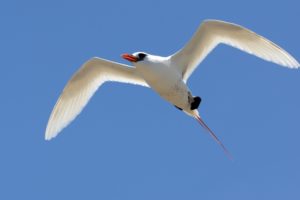
In this village and its surroundings it is not uncommon to encounter herds of zebus, goats or sheep.
The inhabitants of Vezo and Tanala attach great importance to the habits and customs passed down from generation to generation by their ancestors.
Tourism has not changed local cultures: Fady (taboos) and forbidden practices are still respected.
In the south of the village you can see the traditional fishermen's huts, interrupted by some modern foundations.
As everywhere in Madagascar, the ancestors occupy an important place in the lives of the inhabitants.
A paradise for snorkelers and divers
The clarity of the water encourages swimming, especially since the beach is wide.
Let a Dive seduce in a huge aquarium with a thousand unique treasures. Colorful fish, corals and underwater vegetation rub against each other in the turquoise waters. We can provide diving, snorkeling and also surfing in the most beautiful places.
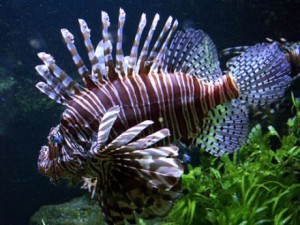
Whether you are a beginner, novice or confirmed diver, we will let you discover its most secret places. CMAS certified instructor and passionate diver for many years, will guide you along the Anakao coral reef, in caves full of lobsters, on coral islands south of Nosy Ve, on shoals near the Saint Augustine trench where you will make amazing encounters...
There are also some very nice deep dives, between 40 and 65 meters for experienced divers.
Coelacanth (Latimeria chalumnae)
Anakao's reputation was enhanced with the discovery of a specimen of Cœlacanthes (a very rare prehistoric fish) forged in 1995.a specimen of it is stuffed and can be seen in a place on request.
Coelacanth (Latimeria chalumnae) were once known only from fossils and were thought to have existed before 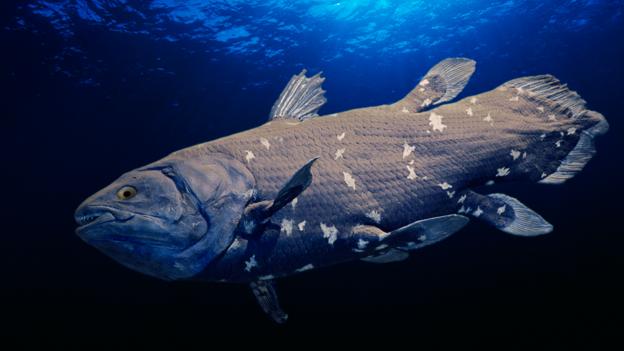
Among living fish, numerous characteristics are unique to the Coelacanth. These include the presence of a "rostral organ" in the snout, which is part of the electrosensory system, and an intracranial joint or "hinge" in the skull that allows the anterior part of the skull to swing upward, greatly enlarging the gap of the mouth. Neither feature is present in any other living vertebrate. Other unique anatomical features include a hollow, fluid-filled "notochord" (a primitive feature in vertebrates) that lies beneath the spinal cord and extends the length of the body, vertebrae that are incompletely formed or completely lack a bony center, an oil-filled gas bladder, fleshy "lobed" or limb-like fins that are internally supported by bone, and paired fins.
This destination is a must visit during a tour in Madagascar.
Two beautiful coral islands
Anakao is nestled between two coral islands: Nosy Ve about 5 km off the coast and Nosy Satrana inside the lagoon, 10 km from the village.
Both are pleasant excursion areas accessible by boat or pirogue.
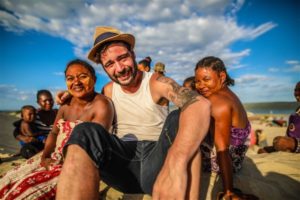
If today man is almost absent from Nosy Ve, many bird species, including the red-tailed phaetons, have made their home there.
Apart from that, it is an excellent place to watch the whales migrate during the southern winter.
Nosy Satrana is located a little further south of Anakao. It is mainly occupied by herons. Its bottom is littered with limestone debris from the fossilized eggs of Aepyornis (a species of giant ostrich).
The freshness of the water allows you to enjoy a good swim.
A timeless stay in another world
Unforgettable scenes A stay in this typical village will allow you to get away from the hectic rhythm of big cities.
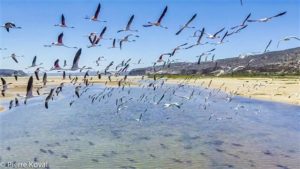
Good to know
Merchants and pirates have lived for centuries on the Nosy Ve Island, about 3 km from Anakao. France settled there in the 19th century. It is still possible to see the traces of their passage, just to mention the basins of the French residence. In Nosy Ve are many Fady (Taboo) to respect.
Climate Anakao benefits from a pleasant climate all year round. The temperatures vary between 25 °C and 29 °C.
It rains mainly in the months of December, January and February. The best time to travel to this destination are May, June, July, August, September to December.

